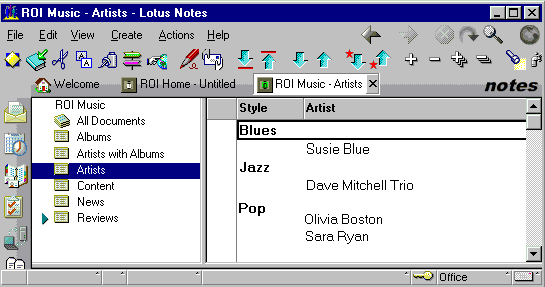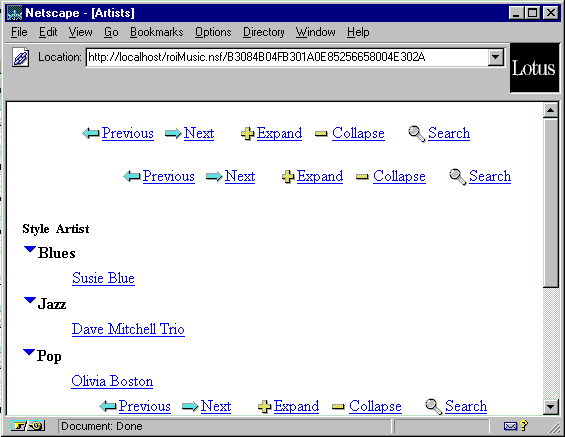Standard outline views
A standard outline view is a table of contents for a database and is the most common type of view. It organizes documents by rows and columns. Each column displays a type of information about the document, such as author or date of creation. Each row displays selected pieces of information from one document. One column in the view is usually the organizing element -- for example, a column entitled Date might organize the documents in chronological order. In a discussion database, you might use a column entitled Topic to display the contents of the Subject field for each document in the view. In a tracking database, a column might show the customer or product name.
Here is the same view from a review database as shown through Netscape Navigator and through Notes®.


To open a document in a standard view, Notes® users double-click a row; Web users click a document link in one of the columns.
A standard view on the Web maintains the column and row format of standard Notes® views (unless you use HTML formatting to customize a view), except that on the Web, a navigation bar at the beginning or end of the screen contains buttons that users click to expand, collapse, and scroll the view.
On the Web, each time a user opens, scrolls, expands, or collapses a view, Domino® converts the view to an HTML page. Each "snapshot" of the view is a newly generated HTML page. The concept of a "selected document" in a view in Notes® does not apply to a view on the Web.
Displaying a view on the Web
By default, views are not enabled for display on the Web. For example, the "For Web Access" properties of the Advanced tab of the View Properties box are not enabled. If you want to create a view for the Web, consider creating a view applet or embedded view applet, as these options give you greater control over the view display.
For more information on designing views for Web applications, see "Displaying views in Web applications."
Limits for views
A view can display no more than 32 levels of responses and/or subcategories. For example, if you have 6 levels of subcategories, you can display 25 levels of responses to a main document. If there are more levels of responses than can be displayed, convert your view to a non-hierarchical, flat view, which displays all documents on a single level (by deselecting "Show response documents in a hierarchy" in the View Properties box).
The combined number of sub-level forms, views, and agents that cascade from the highest level cannot exceed 200; otherwise, the top-level menus do not display properly. This limit does not apply to the number of forms, views, and macros stored at the top level of each menu.
Domino® allows up to 200 cascading view and folder names to be displayed on the View menu.